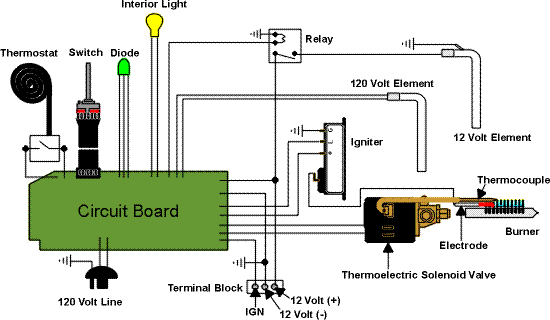Dave's Place
Dometic AES System
Before working with electricity, visit the electrical safety page.
Models included in the first generation of circuit boards:
RM663, RM763, RM1303, RM2602, RM2603, RM2802, RM2803, RM3500, RM3501, RM3600, RM3601, RM3604, RM3800,
RM3801, RM3804, RM4801, RM4804, RM7030.

The Dometic AES (Automatic Energy Selector) system is a system that lets the refrigerator select the most appropriate available heat source. It does this by using a circuit board to sense the power sources available and then chooses the one to use, according to a predetermined order.
The graphic represents the first, circa 1980, Dometic AES refrigerators (RM663, RM763, and RM1303). These were AES only. Later models added the ability for the user to select a heat source, limit the available heat sources, and to check which heat source was being used at a given time, as well as offered full AES. We'll stick with the RM1303 because it's slightly simpler and the later, more refined versions, used all the same components; the only difference being in the communication between the user controls and the circuit board (i.e., if the user selects "gas only", the refrigerator uses the same gas controls, but simply won't switch to AC, even if it were available). We'll also define all these circuit boards as the first generation of circuit boards, which were used between 1980 and the early 90's and were green. The second generation of circuit boards (not covered here) are square, resin filled boards with a black plastic cover. From the users point of view, there appears to be little difference between the first and second generation of circuit boards, but there is substantial difference in the actual components.
On the RM1303 vintage refrigerator, the user turns the refrigerator on and sets the thermostat; the refrigerator then selects the appropriate heat source and changes the heat source as necessary. On later models, the user selects AES and sets the thermostat. An electric thermostat controls the temperature by telling the circuit board when to turn the selected heat source off or on.
The on/off switch is more than a simple single pole contact switch, but is a multi-pole, multi-contact switch which makes certain connections to the circuit board, even in the "off" position. When troubleshooting the AES system, don't overlook the switch as a possible problem. When the switch is turned to the "on" position, the green, light emitting diode comes on. This green diode tells the user only that power is present and the refrigerator is on. It does not necessarily mean everything is functioning properly. Later models replaced the manual switch and diode with an eyebrow circuit board (a small circuit board mounted at the top of the refrigerator with user controls).
To function, the circuit board needs 12 volt DC power. If 12 volt power is not present, the refrigerator will not work on any heat source. If the DC voltage to the refrigerator drops to 9.5 volts, the circuit board senses that the battery is dying and lights the refrigerator on gas in what is referred to as lock-in mode. The green indicator diode goes out to indicate there is a problem. The refrigerator will remain on gas even if AC (120 volt) is present, until full 12 volt power (DC) is restored, at which time the green diode comes back on and normal operation continues. If 12 volt is not restored, the refrigerator will stay on propane until the supply is depleted, and everything in the refrigerator will freeze.
The AES refrigerator chooses its power source by using a preset priority order as follows:
- 120 volt
- 12 volt (only when power is present at the IGN terminal of the main terminal block)
- Propane
If 120 volt is available, the refrigerator will always select it for the power source. If 120 volt is not available, the next power source in order is 12 volt, but only under certain conditions. The refrigerator is designed to use 12 volt power only when the vehicle is running and the batteries are being charged. If 120 volt is not available and the conditions for 12 volt operation are not met, the refrigerator will go to gas (propane) operation.
No Signs of Life
If turning the refrigerator on does nothing (no lights etc.), then first check for 12 volt power to the
refrigerator. If 12 volt power is present at the terminal block, test on through to the circuit board.
Many refrigerators have in line fuses to the circuit board. If 12 volt is present at the
circuit board, inspect the circuit board, all connections to the board, and
the switch mechanism if applicable.
Although it may not be noted in each section below, there are exceptions to every rule. Probably the biggest exception in diagnosing electronics is a bad connection making a component appear to be bad. Always check all plug-ins and connections for good contact before condemning a part.
RV Refrigerator Home
This RV refridgerator information was originally located on rvmobile.comRV Mobile Inc. 11715 HWY 99, Everett, WA 98204
The owner of RV Mobile Inc. apparently suffered a heart attack and the original website was shut down.
It has been reposted here to preserve this wealth of information RV refridgerator information.